IVSL REPRESENTATIVE will receive you on arrival at the airport and transfer to the hotel.
DELHI, the capital of kingdoms and empires is now a sprawling metropolis with a fascinating blend of the past and the present. Delhi is a perfect introduction to the composite culture of an ancient land and a window to the kaleidoscope - that is India.
Relax at the hotel.
Overnight will be at Delhi.
Enjoy breakfast at the hotel.
Transfer to the airport in time for the flight to Kathmandu.
Reach Kathmandu and check into the hotel.
The Katmandu Valley, the political, commercial and cultural hub of Nepal, is the first for the majority of visitors to Nepal. Once a separate kingdom in itself, it contains three fabled cities – Katmandu, Patan and Bhaktapur. Each is an artistic exposition of graceful temples, elegant palaces, brick paved courtyards and quaint streets. There are seven UNESCO World Heritage sites in the valley.
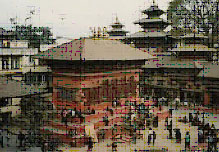 In the afternoon visit the DURBAR SQUARE. It is the historic seat of royalty. The Durbar Square, with its old temples and palaces, epitomizes the religious and cultural life of the people. It is here that kings of Nepal are crowned and their coronations solemnized. Interesting things to see here are: Taleju Temple built by King Mahendra Malla in 1549 AD, the temple of Kal Bhairav, the God of destruction, Nautalle Durbar, Coronation Nasal Chowk, the Gaddi Baithak, the statue of King Pratap Malla, the Big Drum and the Jagannath Temple.
In the afternoon visit the DURBAR SQUARE. It is the historic seat of royalty. The Durbar Square, with its old temples and palaces, epitomizes the religious and cultural life of the people. It is here that kings of Nepal are crowned and their coronations solemnized. Interesting things to see here are: Taleju Temple built by King Mahendra Malla in 1549 AD, the temple of Kal Bhairav, the God of destruction, Nautalle Durbar, Coronation Nasal Chowk, the Gaddi Baithak, the statue of King Pratap Malla, the Big Drum and the Jagannath Temple.
On the right hand corner, a large wooden lattice screen hides an enormous gilded face of Sweta Bhairav. The screen is removed only during the Indra Jatra festival. There are also the Numismatic Museum and Tribhuvan Museum inside the Hanuman Dhoka Palace building. Photography is prohibited inside the museum. Both the museums remain closed on Sundays, Mondays and government holidays.
In the evening enjoy a local dance program with an authentic NEPALI DINNER at the cultural centre.
Overnight will be at Katmandu.
Breakfast will be at hotel.
Proceed for visits to PASUPATINATH, SWAMBHUNATH & BOUDDHNATH.
The temple of Lord Shiva, Pashupatinath, with two tiered golden roof and silver door is considered one of the holiest shrines for Hindu. It is Top Hindu temple of the world. Although only Hindus are allowed inside the temple, visitors can clearly see the temple and the activities performed in the temple premises from the eastern bank of the Baghmati River.
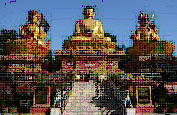 The Buddhist temple of Swayambhunath situated on the top of a hill west of the city is on the most popular and instantly recognizable symbols of Nepal. The temple is colloquially know as the 'monkey temple' after the large tribe of handsome monkeys which guards the hill and amuses visitors and devotees with tricks, including sliding gracefully down the double banisters of the main stairway to the temple. The roving monkeys quickly snatch up any offerings of food made by devotes and will just as quickly grab anything you may be carrying.
The Buddhist temple of Swayambhunath situated on the top of a hill west of the city is on the most popular and instantly recognizable symbols of Nepal. The temple is colloquially know as the 'monkey temple' after the large tribe of handsome monkeys which guards the hill and amuses visitors and devotees with tricks, including sliding gracefully down the double banisters of the main stairway to the temple. The roving monkeys quickly snatch up any offerings of food made by devotes and will just as quickly grab anything you may be carrying.
Proceed to visit BOUDDHANATH. The Stupa of Bouddhanath lies 8 km east of Kathmandu. This ancient colossal Stupa is one of the biggest in the world, and the center of Tibetan Buddhism in the world.
Overnight will be at Kathmandu.
Proceed for a full day visit of PATAN & BHAKTAPUR after breakfast.
Patan, the second-largest city in the valley, lies just across the Baghmati River from Kathmandu, but it's a much quieter and less frenetic place to visit. The city is justly proud of its temples and artisans and it is their handiwork that provides the focus of the stunning Durbar Square - choc-a-block with the largest display of Newari architecture in Nepal. It includes the Royal Palace, which contains a richly decorated bathtub, and the two-tiered brick Jagannarayan Temple.
 Look up to the roof struts to see carvings of figures engaged in quite athletic acts of intercourse. A few minutes' walk north of the square is the Golden Temple, a Buddhist monastery guarded by sacred tortoises that potter around the courtyard; and the Kumbeshawar, reputedly the oldest (1392) temple in Patan. South of the square is an area of charming streets lined with metal smiths and Brassware shops. Patan's other attractions are flung further. Among them is a collection of four stupas, thought to have been built over 2500 years ago, and Nepal's only zoo, which features a reasonable assortment of rhinos, tigers, leopards and bird life. Palm readers gather in the park outside - they may be able to point out which animal you'll be reincarnated as.
Look up to the roof struts to see carvings of figures engaged in quite athletic acts of intercourse. A few minutes' walk north of the square is the Golden Temple, a Buddhist monastery guarded by sacred tortoises that potter around the courtyard; and the Kumbeshawar, reputedly the oldest (1392) temple in Patan. South of the square is an area of charming streets lined with metal smiths and Brassware shops. Patan's other attractions are flung further. Among them is a collection of four stupas, thought to have been built over 2500 years ago, and Nepal's only zoo, which features a reasonable assortment of rhinos, tigers, leopards and bird life. Palm readers gather in the park outside - they may be able to point out which animal you'll be reincarnated as.
Situated at an altitude of 1,401m, Bhaktapur covers an area of four square miles. Bhaktapur or the city of Devotees still retains a medieval charm and visitors to this ancient town are treated to myriad wonders of cultural and artistic achievements. The past glory of the Malla rulers continues to be reflected at the Durbar Square. Pottery and weaving are its traditional industries. Bhaktapur is famous for woodcarving, the Bhadgaolen topi (cap) and curd. The city lies about 14 km east of Kathmandu.
Overnight will be at Kathmandu.
Paro – Thimphu By Road 1hr
Breakfast will be at the hotel.
Transfer to the airport to take the flight to Paro via Kathmandu. On a clear day the panoramic views of the Himalaya are sensational, including Everest, but particularly exciting is the approach through the Bhutanese foothills and the landing, including a few steep turns to land at the tiny airstrip of Paro.
In Paro you will be received by your Bhutanese guide and transferred to the capital town of Thimphu.
There are a good many things to see in the capital, which has a very relaxed, laid-back feel about it. Thimphu is relatively small having a population of approximately 90,000 people and the streets are wide and tree lined.
In the afternoon proceed to visit the market and Traschichhoedzong, beautiful medieval fortress/monastery.
Overnight will be at the hotel.
Breakfast will be at the resort.
Explore THIMPU.
Takin Preserve: TAKIN is the Ntaional animal of Bhutan. They are like a mix between cows and goats. These oddball mammals are really harmless and just lazily roam around.
Trashi Chhoe Dzong: Situated on the West bank of River Wang Chhu, it is a whitewashed brilliant building with red and gold triple tiered roofs looks more like a monastery. The outer walls are lined neatly with granite blocks unlike other dzongs, which have rough stones as walls.
Phodrang: It is the state monastic school and 15 teachers take classes of around 400 pupils over 8 years. Walking around the school feels special as different chants and hymns could be heard drifting out of the windows.
Return to the beautiful hotel and you would watch a fencing match today if time permits.
Overnight will be in Thimpu.
After breakfast drive to Punakha.
Start your tour and exploring of the region.
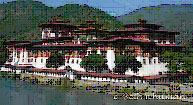 Punakha Dzong: Placed strategically at the junction of the Pho Chu and Mo Chu rivers, the dzong was built in 1637 by Zhabdrung Ngawang Namgyal to serve as the religious and administrative seat of the region. It was here that the dual system of government was introduced in the 17th century and in 1907, enthroned the first King Gongsr Ugyen Wangchuck. Damaged over the centuries by four catastrophic fires and an earthquake, the dzong has been fully restored in the recent years by the 4th King Jigme Singye Wangchuck. At the dzong enrich your trip with the opportunity to see the highest standards in woodwork. Do not miss the massive Kuenray, the Coronation Hall of all Bhutanese kings, the Dzongchung at the entrance to the dzong and the cantilever bridge over the Mochu that has been recently renovated.
Punakha Dzong: Placed strategically at the junction of the Pho Chu and Mo Chu rivers, the dzong was built in 1637 by Zhabdrung Ngawang Namgyal to serve as the religious and administrative seat of the region. It was here that the dual system of government was introduced in the 17th century and in 1907, enthroned the first King Gongsr Ugyen Wangchuck. Damaged over the centuries by four catastrophic fires and an earthquake, the dzong has been fully restored in the recent years by the 4th King Jigme Singye Wangchuck. At the dzong enrich your trip with the opportunity to see the highest standards in woodwork. Do not miss the massive Kuenray, the Coronation Hall of all Bhutanese kings, the Dzongchung at the entrance to the dzong and the cantilever bridge over the Mochu that has been recently renovated.
Khamshum Yalley Temple: There is no temple in Bhutan built elaborately as this. The Queen Mother of the 5th King to bring universal peace in this world built this fascinating temple. The best of the spiritual art works are painted on the inner walls. There are also paintings of Buddhist teachers and tutelary deities of the country. This is a great temple to study the symbolic meanings from frescoes and sculptures.
Chhimi Lhakhang: The divine madman also known, as Drukpa Kinley is a famous teacher with whom the phallic symbol is associated. Tales told by your guide would have excited you to visit Chhimi Lhakhang. The Divine Madman sits there though a statue this time. Do not miss the master’s deeds painted on the walls.
Overnight will be at Punakha.
Breakfast will be at the resort.
Proceed for excursion of Wangdue Phodrang.
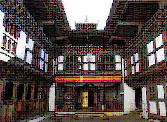 Wangdue Phodrang Dzong: Stretched along the hilltop above the confluence of the Punatsangchhu and Dhangchhu rivers, the imposing Wangdue Phodrang Dzong is the town’s most visible feature. During pre-monarchy days, the governor of this dzong played an important role. The annual festival takes place in autumn so be the guest and enjoy the tour of the dzong.
Wangdue Phodrang Dzong: Stretched along the hilltop above the confluence of the Punatsangchhu and Dhangchhu rivers, the imposing Wangdue Phodrang Dzong is the town’s most visible feature. During pre-monarchy days, the governor of this dzong played an important role. The annual festival takes place in autumn so be the guest and enjoy the tour of the dzong.
Later drive to Paro and check into resort and relax.
Overnight will be at Paro.
Breakfast will be at hotel. Proceed for the sightseeing of Paro.
Drukgyel Dzong: Let the ruins of this dzong tell you a tale of how Bhutanese warriors defended Bhutan from the invaders from the north in the 17th century. Zhabdrung Ngawang Namgyal built this dzong in 1646, to commemorate his victory over the Tibetan invaders. Though largely destroyed by fire in 1951, the outer walls and the central tower remain an imposing sight. On a clear day, treat yourself with a splendid view of Mt. Jumolhari from the approach road to Drukgyel Dzong.
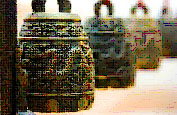 Rinpung Dzong: Explore the Rinpung Dzong, which the locals call the ‘fortress of a heap of jewels’. Built in 1646 by Zhabdrung Ngawang Namgyal, the dzong stands on a hill above Paro Township. It is linked by the traditional cantilever bridge (called the Nemi Zam) over the Pa chu where one may pose a photograph. Experience a walk up a paved stone path running alongside the imposing outer walls. Once inside the Dzong, the monks, architecture and the ancient frescoes, will welcome you.
Rinpung Dzong: Explore the Rinpung Dzong, which the locals call the ‘fortress of a heap of jewels’. Built in 1646 by Zhabdrung Ngawang Namgyal, the dzong stands on a hill above Paro Township. It is linked by the traditional cantilever bridge (called the Nemi Zam) over the Pa chu where one may pose a photograph. Experience a walk up a paved stone path running alongside the imposing outer walls. Once inside the Dzong, the monks, architecture and the ancient frescoes, will welcome you.
Ta Dzong: On a ridge immediately above Rinpung Dzong is the Ta Dzong, built as a watchtower to protect the Dzong from intruders and warring factions. In 1968 Paro’s Ta Dzong was inaugurated as the National Museum, and now holds a fascinating collection of art, relics, religious thangkha paintings, Bhutan’s exquisite postage stamps, coins and handicrafts, together with a small natural history collection.
Kyichu Lhakhang: Kyichu is one of the oldest temples in Bhutan built in the 7th century by Tibetan King Songtsen Gampo. The story goes that a giant daemon lay across Tibet and the Himalayas, which was preventing the spread of Buddhism. To overcome her, King Songtsen Gampo decided to build 108 temples in a single day to pin the ogress to the earth forever in 659AD. Of these 108 temples, 12 were built in accordance with precise plans at key points. The temple of Jokhang in LHASA was built over the very heart of the daemon while KICHU was built on the left foot. Dungtse Lhakhang was constructed by the great bridge-builder Thangtong Gyelpo in 1433. It was built on the head of daemon that was causing illness to the inhabitants. The building was restored in 1841 and is a unique repository of Kagyu lineage arts. You may or may not be permitted inside but can walk around this three-storey Chorten-type building.
Overnight will be at Paro.
Breakfast will be at the hotel.
Proceed to the airport to take the flight to Delhi. Reach Delhi and get transferred to hotel.
Overnight stay will be at hotel.
Enjoy a guided tour of Old Delhi after breakfast.
The tour will begin with a visit to Raj Ghat, a simple memorial to Mahatma Gandhi. He is also famously known as the “father of the nation”.
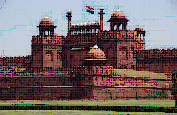 One of the most important buildings of Old Delhi is the RED FORT. The magnificent Red Fort was built during the years 1638 – 48 when the Mughal Empire was at its peak. In 1638 Shahjahan transferred his capital from Agra to Delhi and laid the foundations of Shahjahanabad, the seventh city of Delhi. It is enclosed by a rubble stonewall, with bastions, gates and wickets at intervals. Of its fourteen gates, the important ones are the Mori, Lahauri, Ajmeri, Turkman, Kashmiri and Delhi gates, some of which have already been demolished. His famous citadel, the Lal-Qila, or the Red Fort, lying at the town's northern end on the right bank or the Yamuna and south of Salim Garh, was begun in 1639 and completed after nine years. The Red Fort is different from the Agra fort and is better planned, because at its back lies the experience gained by Shahjahan at Agra, and because it was the work of one hand. It is an irregular octagon, with two long sides on the east and west, and with two main gates, one on the west and the other on the south, called Lahauri and Delhi gates respectively. While the walls, gates and a few other structures in the fort are constructed of red sandstone, marble has been largely used in the palaces.
One of the most important buildings of Old Delhi is the RED FORT. The magnificent Red Fort was built during the years 1638 – 48 when the Mughal Empire was at its peak. In 1638 Shahjahan transferred his capital from Agra to Delhi and laid the foundations of Shahjahanabad, the seventh city of Delhi. It is enclosed by a rubble stonewall, with bastions, gates and wickets at intervals. Of its fourteen gates, the important ones are the Mori, Lahauri, Ajmeri, Turkman, Kashmiri and Delhi gates, some of which have already been demolished. His famous citadel, the Lal-Qila, or the Red Fort, lying at the town's northern end on the right bank or the Yamuna and south of Salim Garh, was begun in 1639 and completed after nine years. The Red Fort is different from the Agra fort and is better planned, because at its back lies the experience gained by Shahjahan at Agra, and because it was the work of one hand. It is an irregular octagon, with two long sides on the east and west, and with two main gates, one on the west and the other on the south, called Lahauri and Delhi gates respectively. While the walls, gates and a few other structures in the fort are constructed of red sandstone, marble has been largely used in the palaces.
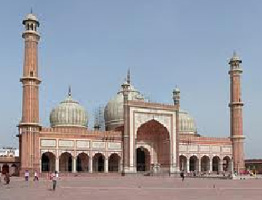 Continue your tour to Jama Masjid by bicycle rickshaws, one of Asia’s largest mosques. People stream in and out of the mosque continuously and the presence of a nearby bazaar means that the area is rarely quiet.
Continue your tour to Jama Masjid by bicycle rickshaws, one of Asia’s largest mosques. People stream in and out of the mosque continuously and the presence of a nearby bazaar means that the area is rarely quiet.
Enjoy the rickshaw ride at Old Delhi peddling through the narrow by lanes of Chandani Chowk.
After lunch proceed for a sightseeing tour of New Delhi, which reflects the legacy of the British left behind. The division between New and Old Delhi is the division between the capitals of the British and the Mughals respectively. The division in the walled city and New Delhi also marks the division in the life-styles. The walled city is all tradition where one will be able to glean a past life-style in all its facets, colors and spells. New Delhi in contrast, is a city trying to live up to the best of 21st century standards.
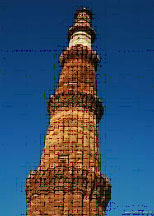 Imperial Delhi will include the Qutub Minar, the tallest stone tower in India. Qutub-Minar in red and buff stand stone is the highest tower in India. It has a diameter of 14.32 m at the base and about 2.75 m on the top with a height of 72.5 m. Qutbu'd-Din Aibak laid the foundation of Minar in AD 1199 for the use of the mu'azzin (crier) to give calls for prayer and raised the first floor, to which were added three more floors by his successor and son-in-law, Shamsu'd-Din Iltutmish (AD 1211-36). All the storeys are surrounded by a projected balcony encircling the Minar and supported by stone brackets, which are decorated with honeycomb design, more conspicuously in the first floor.
Imperial Delhi will include the Qutub Minar, the tallest stone tower in India. Qutub-Minar in red and buff stand stone is the highest tower in India. It has a diameter of 14.32 m at the base and about 2.75 m on the top with a height of 72.5 m. Qutbu'd-Din Aibak laid the foundation of Minar in AD 1199 for the use of the mu'azzin (crier) to give calls for prayer and raised the first floor, to which were added three more floors by his successor and son-in-law, Shamsu'd-Din Iltutmish (AD 1211-36). All the storeys are surrounded by a projected balcony encircling the Minar and supported by stone brackets, which are decorated with honeycomb design, more conspicuously in the first floor.
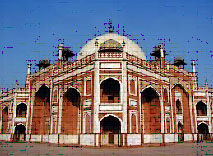 Next stop would be the majestic Humanyun’s Tomb. Humayun died in 1556, and his widow Hamida Banu Begum, also known as Haji Begum, commenced the construction of his tomb in 1569, fourteen years after his death. It is the first distinct example of proper Mughal style, which was inspired by Persian architecture.
Next stop would be the majestic Humanyun’s Tomb. Humayun died in 1556, and his widow Hamida Banu Begum, also known as Haji Begum, commenced the construction of his tomb in 1569, fourteen years after his death. It is the first distinct example of proper Mughal style, which was inspired by Persian architecture.
It is well known that Humayun picked up the principles of Persian architecture during his exile, and he himself is likely to have planned the tomb, although there is no record to that effect.
The tour also includes a drive past the imposing India Gate, the Parliament building and the Rashtrapati Bhawan, the President’s residence.
Overnight will be at Delhi.
Proceed to Agra early in the morning after breakfast. Reach and check in at hotel.
Agra: Two great Mughal monarchs, Akbar and Shahjahan, transformed the little village of Agra into a befitting second capital of the Mughal Empire - giving it the name Dar-ul-Khilafat {seat of the Emperor}. Today a visitor to Agra is caught up in a world of contrasting edifices, of red sandstone and white marble, narrow galleys and quaint buggies, and that irresistible charm that this favorite city of the Mughals still retains. It is not surprising, that modern Agra still reflects its Mughal heritage most conspicuously. A walk down the narrow bustling streets of the city will introduce the visitor to the wafting aroma of Mughlai cuisine.
Agra Sightseeing
Proceed for day sightseeing of Agra.
 Taj Mahal: - Little needs to be said about this architectural wonder which is always the soul raison-de-etre for every tourist's visit to Agra. Built by Shah Jahan, the Taj is a white marble memorial to his beautiful wife Mumtaz Mahal. This monument took 22 years to be completed and was designed, and planned by Persian architect Ustad Isa. Apart from its stunning design balance and perfect symmetry, the Taj is also noted particularly for its elegant domes, intricately carved screens and some of the best inlay work ever seen.
Taj Mahal: - Little needs to be said about this architectural wonder which is always the soul raison-de-etre for every tourist's visit to Agra. Built by Shah Jahan, the Taj is a white marble memorial to his beautiful wife Mumtaz Mahal. This monument took 22 years to be completed and was designed, and planned by Persian architect Ustad Isa. Apart from its stunning design balance and perfect symmetry, the Taj is also noted particularly for its elegant domes, intricately carved screens and some of the best inlay work ever seen.
Agra Fort: - The red sandstone structure is surrounded by chahar-bagh, a four-square formal garden. Built by the famed Mughal emperor Akbar in 1565 AD, the fort is predominantly of red sandstone. Ensconced within is the picture perfect Pearl Mosque, which is a major tourist attraction. It lies on the bend of the river Yamuna, almost in the heart of the town. Akbar built it as his citadel over the years 1563-73 in the finest architectural style. It has imposing gates and walls of red sandstone and a moat.
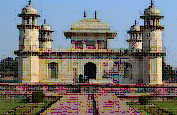 After Agra Fort we will visit Baby Taj or the Itmad-Ud-Ullah – The interiors of which are considered better than the Taj. One of the most beautiful Mughal tombs, Itmad-Ud-Daulah's Tomb was built by Noor Jahan, the Empress of Jahangir for her father in 1628. The tomb is a resting place of the powerful personality in Mughal Court, Itmad-Ud-Daulah, whose life is very interesting. Formerly a very poor Persian merchant then named Mirza Ghiyas or Ghiyas Beg he became a minister and a trusted treasure in Akbar's court. After Akbar's death in 1605, his son Jahangir rose into power. Jahangir made Ghiyas Beg his chief minister and honored him with the title of Itmad-Ud-Daulah, the Pillar of State. Later, Jahangir met a beautiful daughter of Ghiyas Beg named Mehr-Un-Nissa and married her. Mehr-Un-Nissa soon played a significant role in the Jahangir's court and was called Noor Mahal, the light of the Place. Owing to her influence, her father and brother were granted with privileges in the court. When Ghiyas beg (Itmad-Ud-Daulah) dies in 1622, Noor Mahal decided to build a mausoleum for him. Queen Mumtaz Mahal or the lady of the Taj was also from this prevailing family. The mausoleum is entirely made of white marble and graced with intricate decoration of inlay work, and marble-screen work belonging to the Islamic style. With its tranquil, small garden on the bank of Yamuna River, the tomb stands impressively elegant from a distance.
After Agra Fort we will visit Baby Taj or the Itmad-Ud-Ullah – The interiors of which are considered better than the Taj. One of the most beautiful Mughal tombs, Itmad-Ud-Daulah's Tomb was built by Noor Jahan, the Empress of Jahangir for her father in 1628. The tomb is a resting place of the powerful personality in Mughal Court, Itmad-Ud-Daulah, whose life is very interesting. Formerly a very poor Persian merchant then named Mirza Ghiyas or Ghiyas Beg he became a minister and a trusted treasure in Akbar's court. After Akbar's death in 1605, his son Jahangir rose into power. Jahangir made Ghiyas Beg his chief minister and honored him with the title of Itmad-Ud-Daulah, the Pillar of State. Later, Jahangir met a beautiful daughter of Ghiyas Beg named Mehr-Un-Nissa and married her. Mehr-Un-Nissa soon played a significant role in the Jahangir's court and was called Noor Mahal, the light of the Place. Owing to her influence, her father and brother were granted with privileges in the court. When Ghiyas beg (Itmad-Ud-Daulah) dies in 1622, Noor Mahal decided to build a mausoleum for him. Queen Mumtaz Mahal or the lady of the Taj was also from this prevailing family. The mausoleum is entirely made of white marble and graced with intricate decoration of inlay work, and marble-screen work belonging to the Islamic style. With its tranquil, small garden on the bank of Yamuna River, the tomb stands impressively elegant from a distance.
Overnight will be at Agra.
Breakfast will be served at the hotel.
Proceed to Jaipur by road. Visit Fatehpur Sikri en route.
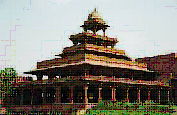 Fatehpur Sikri - is 37 km west of Agra. Jajal-ud-din-Muhammad Akbar, Humanyun's son, accessed the throne at the tender age of 14. While hunting around Sikri his curiosity was aroused by the songs of some minstrels about the celebrated Khwaja -Mu'inu'd-din Chisti, the founder of the Chisti order of SUFIS. Akbar, who was without a male heir heard about Saint Salim Chisti and visited him in the year 1568. The saint blessed him with 3 sons and in gratitude Akbar ordered the great mosque of Fatehpur Sikri built under his supervision. As a mark of respect to the saint, Akbar shifted his capital to Fatehpur Sikri and built various secular buildings like the Diwan -I-Am, Diwan-I-Khas, Jodhabai palace, Birbal's house, Marian's house and the Panchmahal.
Fatehpur Sikri - is 37 km west of Agra. Jajal-ud-din-Muhammad Akbar, Humanyun's son, accessed the throne at the tender age of 14. While hunting around Sikri his curiosity was aroused by the songs of some minstrels about the celebrated Khwaja -Mu'inu'd-din Chisti, the founder of the Chisti order of SUFIS. Akbar, who was without a male heir heard about Saint Salim Chisti and visited him in the year 1568. The saint blessed him with 3 sons and in gratitude Akbar ordered the great mosque of Fatehpur Sikri built under his supervision. As a mark of respect to the saint, Akbar shifted his capital to Fatehpur Sikri and built various secular buildings like the Diwan -I-Am, Diwan-I-Khas, Jodhabai palace, Birbal's house, Marian's house and the Panchmahal.
The deserted, red Sandstone City, Emperor Akbar built that as his capital and palace in the late 16th century is an exhilarating experience. It a veritable fairytale city and its "ruins" are in pristine condition. It's not hard to imagine what the court life must have been like in the days of its grandeur. Also visit the Buland Darwaza, the largest gateway in the world.
Continue your drive to Jaipur. Reach and transfer to hotel.
Jaipur is the capital of the state of Rajasthan a romantic realm of resplendent palaces, mighty fortresses and regal Maharajahs that lies in the western deserts and is an utterly unique part of India. Proudly belonging to the KSHATRIYA warrior caste and fiercely independent, the Rajput princes made fearsome foes. However, many of them realized that to maintain their wealth and authority locally, it was expedient to proclaim allegiance to the central power. Thus, many enjoyed a privileged position under the Mughal emperors and also the British Raj that followed.
The bustling Rajasthan capital of Jaipur takes its name from its venerated founder Jai Singh II, who was given the title Sawai Maharaja by the Mughal. Literally translated this would mean ’one and a quarter’, suggesting that the Mughal thought this emperor to be more valuable than just ‘one’. Jaipur is known as the ’Pink City’ on account of the distinctive color of its buildings. This did not, however, form part of the original plan, but dates back to 1856, when the city was given a wash of pink in honor of a State Visit from Prince Albert.
This evening, you can enjoy an exuberant Rajasthani Folk Dance Performance and a puppetry show, performed by a local tribe, followed by dinner consisting of typical Indian cuisine.
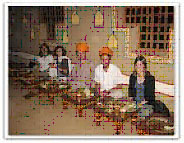 In the magical land of Rajasthan where the heat shimmers like phantom water, where the things you see are not really there and where the things that vanish behind veils of illusion, stands Chokhi Dhani, an ethnic village resort with a blend of rustic environment and modern amenities making it an important destination in Pink City.
In the magical land of Rajasthan where the heat shimmers like phantom water, where the things you see are not really there and where the things that vanish behind veils of illusion, stands Chokhi Dhani, an ethnic village resort with a blend of rustic environment and modern amenities making it an important destination in Pink City.
Evening visit Crystal Gallery to visit MAHARAJA’s Private collections.
Enjoy the experience and spend the night at Jaipur.
Proceed for a morning excursion to Amber Fort after breakfast. Elephant ride ascent to the fort.
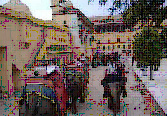 Amber Fort Palace: Amber is the classic romantic Rajasthani fort palace. Its construction was started by Man Singh I in 1592, and completed by his descendent Jai Singh I. Its forbidding exterior belies an inner paradise where a beautiful fusion of Mughal and Hindu styles finds its ultimate expression.
Amber Fort Palace: Amber is the classic romantic Rajasthani fort palace. Its construction was started by Man Singh I in 1592, and completed by his descendent Jai Singh I. Its forbidding exterior belies an inner paradise where a beautiful fusion of Mughal and Hindu styles finds its ultimate expression.
Continue sightseeing.
City Palace: A delightful blend of Mughal and traditional Rajasthani architecture, the City Palace sprawls over one-seventh of the area in the walled city. It houses the Chandra Mahal, Shri Govind Dev Temple and the City Palace Museum.
Jantar Mantar: This is the largest and the best preserved of the five observatories built by Jai Singh II in different parts of the country. This observatory consisting of outsized astronomical instruments is still in use.
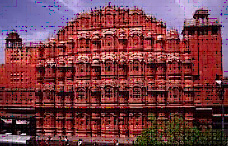 Hawa Mahal: The ornamental facade of this "Palace of Winds" is a prominent landmark in Jaipur. It is a five-storey structure of sandstone plastered pink encrusted with fine trelliswork and elaborate balconies. The palace has 953 niches and windows. Built in 1799 by Pratap Singh, the Mahal was a royal grandstand for the palace women.
Hawa Mahal: The ornamental facade of this "Palace of Winds" is a prominent landmark in Jaipur. It is a five-storey structure of sandstone plastered pink encrusted with fine trelliswork and elaborate balconies. The palace has 953 niches and windows. Built in 1799 by Pratap Singh, the Mahal was a royal grandstand for the palace women.
Relax in the evening or visit the markets.
Overnight will be at Jaipur.
Enjoy breakfast at the hotel.
Proceed to Delhi to get transferred to the international airport take the flight back home with sweet memories of the tour.
TOUR ENDS!!